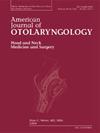伊朗女性在SNOT-22上报告了更严重的症状:一项基于人群的横断面研究
IF 1.7
4区 医学
Q2 OTORHINOLARYNGOLOGY
引用次数: 0
摘要
目的鼻窦炎包括一组以鼻粘膜和鼻窦炎症为特征的疾病,影响患者的生活质量。本研究旨在使用SNOT-22问卷评估普通人群的生活质量。本研究旨在使用SNOT-22问卷评估普通人群的生活质量,该问卷是衡量与鼻科问题相关的生活质量的工具。材料和方法这项基于人群的横断面研究是霍韦泽队列研究基线评估的一部分,重点关注伊朗西南部35-70岁的成年人。收集了与社会经济因素、人口特征和人体测量相关的数据。随后,随机抽取1324人参加了这项研究,完成了SNOT-22自报问卷。结果1324名参与者的平均年龄为49.92±8.97岁,其中约60%为女性。SNOT-22的平均得分为7.84±10.78。大约34%的参与者在SNOT-22问卷上的得分异常。这些参与者被评估了与鼻腔、耳科、睡眠和情绪症状相关的领域。报告的最常见问题分别是打喷嚏、头晕或眩晕、醒来时感到疲倦和悲伤。我们观察到,女性SNOT-22评分异常的几率比男性高62%。结论我们的研究结果显示,SNOT-22评分异常的患病率相对较高,尤其是在女性中。因此,为这些人设计和实施治疗和教育干预措施似乎是必要的。本文章由计算机程序翻译,如有差异,请以英文原文为准。
Iranian females report more severe symptoms on the SNOT-22: A cross-sectional population-based study
Purpose
Rhinosinusitis encompasses a group of conditions characterized by inflammation of the nasal mucosa and paranasal sinuses, impacting the quality of life for those affected. This study was designed to assess the quality of life in the general population using the SNOT-22 questionnaire.
This study was designed to assess quality of life among the general population using the SNOT-22 questionnaire, which is a tool for measuring quality of life related to rhinological issues.
Material and methods
This population-based cross-sectional study was conducted as part of the baseline assessment for the Hoveyzeh cohort study, focusing on adults aged 35–70 in southwest Iran. Data related to socioeconomic factors, demographic characteristics, and anthropometric measurements were gathered. Subsequently, a random sample of 1324 individuals participated in the study, completing the Self-reported SNOT-22 questionnaire.
Result
The mean age of 1324 participants was 49.92 ± 8.97 years, and about 60 % were women. The average SNOT-22 score was 7.84 ± 10.78. Approximately 34 % of the participants had an abnormal score on the SNOT-22 questionnaire. These participants were assessed for domains related to nasal, otologic, sleep and emotional symptoms. The most common issues reported were sneezing, dizziness or vertigo, waking up tired, and feelings of sadness, respectively. We observed that the odds of having an abnormal SNOT-22 scores were 62 % higher in women compared to men.
Conclusion
Our results revealed a relatively higher prevalence of abnormal SNOT-22 scores, especially among women. Therefore, designing and implementing therapeutic and educational interventions for these people seems necessary.
求助全文
通过发布文献求助,成功后即可免费获取论文全文。
去求助
来源期刊

American Journal of Otolaryngology
医学-耳鼻喉科学
CiteScore
4.40
自引率
4.00%
发文量
378
审稿时长
41 days
期刊介绍:
Be fully informed about developments in otology, neurotology, audiology, rhinology, allergy, laryngology, speech science, bronchoesophagology, facial plastic surgery, and head and neck surgery. Featured sections include original contributions, grand rounds, current reviews, case reports and socioeconomics.
 求助内容:
求助内容: 应助结果提醒方式:
应助结果提醒方式:


